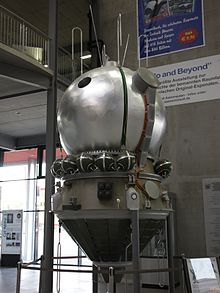
Summary
The S5.4 (AKA TDU-1, GRAU Index 8D66), was a Russian liquid rocket engine burning TG-02 and AK20F in the gas generator cycle. It was originally used as the braking (deorbit) engine of the Vostok, Voskhod, and Zenit spacecraft, which later switched to solid engines.[citation needed]
 Vostok spacecraft replica at the Technik Museum Speyer, Germany. The lower conical section was the service module with the S5.4/TDU-1 engine. | |
| Country of origin | USSR |
|---|---|
| Date | 1959-1961 |
| First flight | 1959 |
| Designer | OKB-2, A.M. Isaev |
| Application | Spacecraft breaking engine |
| Successor | S5.35 |
| Status | Retired |
| Liquid-fuel engine | |
| Propellant | AK20F / TG-02 |
| Mixture ratio | 3.07 |
| Cycle | Gas Generator |
| Configuration | |
| Chamber | 1 main + 4 vernier |
| Performance | |
| Thrust, vacuum | 15.83 kilonewtons (3,560 lbf) |
| Chamber pressure | 5.6 megapascals (810 psi) |
| Specific impulse, vacuum | 266 seconds |
| Burn time | 45 seconds |
| Propellant capacity | 250 kilograms (550 lb) |
| Dimensions | |
| Length | 1.13 metres (44 in) |
| Diameter | 0.95 metres (37 in) |
| Dry weight | 98 kilograms (216 lb) |
| Used in | |
| Vostok, Voskhod and Zenit | |
| References | |
| References | [1][2][3] |
The engine produced 15.83 kilonewtons (3,560 lbf) of thrust with a specific impulse of 266 seconds in vacuum, and burned for 45 seconds, enough for the deorbit. It had a main fixed combustion chamber and four small verniers to supply vector control. It was housed in the service module and had two toroidal tanks for pressurization.[4][5][6]
It was designed by OKB-2, the Design Bureau led by Aleksei Isaev, for the Vostok program. The braking engine for the first manned spacecraft was a difficult task that no design bureau wanted to take.[citation needed] It was considered critical, as a failure would have left a cosmonaut stranded in space. A solid engine was considered, but the ballistic experts predicted a 500-kilometer (270-nautical-mile) landing error, versus a tenth of that for a liquid engine. It took the coordinated efforts of Boris Chertok and Sergei Korolev to convince Isaev to accept the task.[7]
References edit
- ^ Brügge, Norbert. "Spacecraft-propulsion blocks (KDU) from Isayev's design bureau (now Khimmash)". B14643.de. Archived from the original on 2015-06-02. Retrieved 2015-06-02.
- ^ "S5.4". Encyclopedia Astronautica. Archived from the original on August 27, 2002. Retrieved 2015-07-25.
- ^ Pillet, Nicolas. "Le vaisseau Vostok" [The Vostk spacecraft] (in French). Kosmonavtika.com. Retrieved 2015-07-25.
- ^ Zak, Anatoly. "Origin of the Vostok spacecraft". RussianSpaceWeb. Retrieved 2015-07-25.
- ^ LePage, Andrew J. "Vostok: an aerospace classic". The Space Review. Retrieved 2015-07-15.
- ^ Turner, Martin J. L. (2008). "Section 9.2 — Crewed launchers and re-entry vehicles". Rocket and Spacecraft Propulsion: Principles, Practice and New Developments. Springer Science & Business Media. p. 314. ISBN 978-3540692034. Retrieved 2015-07-15.
- ^ Chertok, Boris (May 2009). "Chapter 2 — Preparation for Piloted Flights". Rockets and People Vol. 3 — Hot Days of the Cold War (PDF). Vol. 3 (NASA SP-2006-4110). NASA. p. 26. ISBN 978-0-16-081733-5. Retrieved 2015-07-15.
External links edit
- KB KhIMMASH Official Page (in Russian, Archived)


